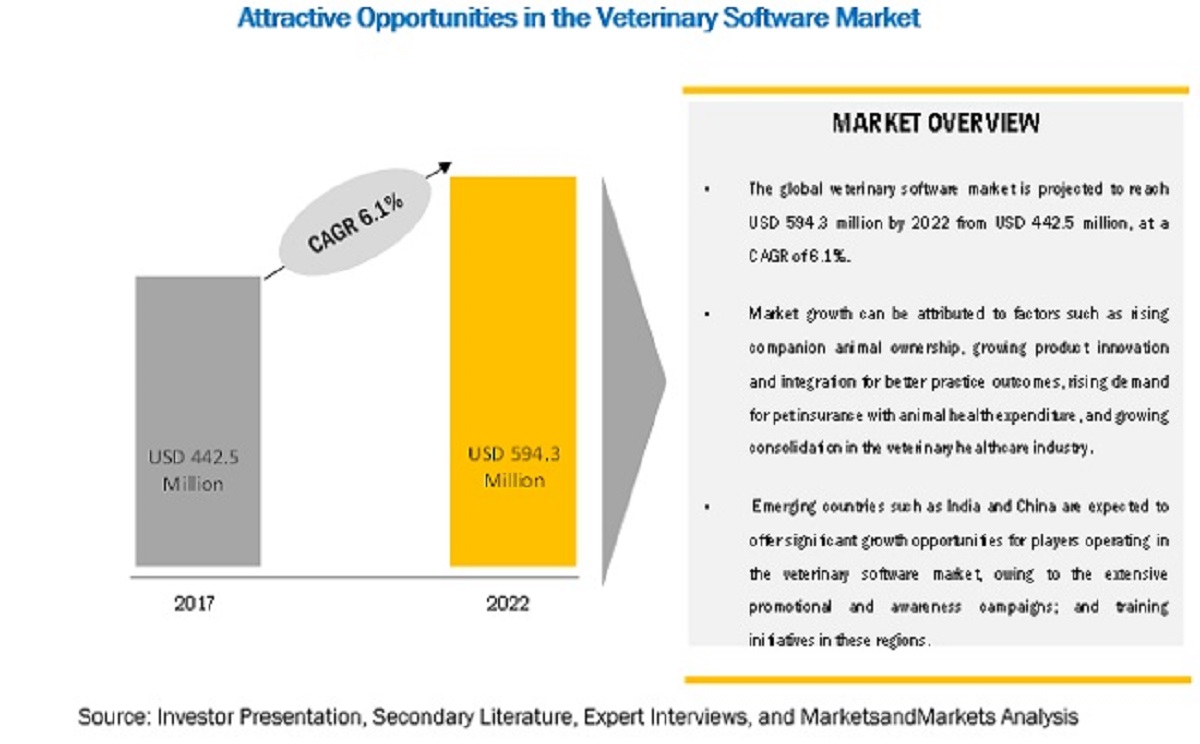The major factors that are expected to be driving the veterinary software market are rising companion animal ownership and demand for pet insurance with growing animal health expenditure. However, lack of government incentives for the adoption of veterinary software, reluctance of veterinarians towards adopting new technologies, and lack of awareness about veterinary software in the developing countries are restricting the growth of this market.
[169 Pages Report] MarketsandMarkets forecasts the veterinary software market to grow from USD 442 million in 2017 to USD 594 million by 2022, at a Compound Annual Growth Rate (CAGR) of 6.1% during the forecast period.
Veterinary Software Market by Product (Practice Management, Imaging, BI, Marketing), Delivery Model (On Premise, Cloud), Practice (Small Animal, Mixed, Large, Equine, Bovine), End User (Hospitals, Clinics, ASC, Emergency) – Global Forecasts To 2022
Download a PDF Brochure @ https://www.marketsandmarkets.com/pdfdownloadNew.asp?id=186264514
Market Dynamics
Driver:Rising companion animal ownership
Restraint: Lack of Government incentives
Opportunity: Web-based/cloud-based models
Challenge: Meeting region-wise requirements for software functions
Driver:Rising companion animal ownership
Over the years, the number of pet owners has increased significantly across the globe, and this trend is expected to continue in the coming years. According to the American Pet Products Association’s 2017– 2018 National Pet Owners Survey, 68% of households (84.6 million) in the US owned a pet. The canine population in the US increased from 69.90 million in 2012 to 89.70 million in 2016, while the feline population increased from 74.05 million in 2012 to 94.20 million in 2016. Similarly, according to the European Pet Food Industry Federation (FEDIAF), the canine population in Germany increased from 5.30 million in 2012 to 8.60 million in 2016, whereas the feline population in the country increased from 11.80 million in 2014 to 13.40 million in 2016. In the UK, as of 2017, 44% of households own pets (Source: Pet Food Manufacturers Association).
Restraint: Lack of Government incentives
The veterinary software market has minimal support from governments across the globe. In the US, the adoption rate of veterinary software is very low as compared to healthcare IT (HCIT) tools such as human EHR. This can be attributed to the lack of incentives or funding provided for implementing veterinary software. The slow adoption rate of veterinary software will make it difficult for small vendors to break even in the market. Moreover, in developing regions such as the Asia Pacific and Latin America, government support for the implementation of veterinary software is very low. This makes it difficult for companies to operate in these regions. Thus, the lack of government incentives is restraining the growth of the veterinary software market.
Request a Sample Pages @ https://www.marketsandmarkets.com/requestsampleNew.asp?id=186264514
Recent Developments
In 2017, Vetter Software partnered with Vetstoria to integrate Vetter’s practice management solution with Vetstoria’s online appointment booking solution
In 2017, Vetter Software partnered with Pawprint, (the mobile pet health app) to integrate Vetter’s practice management solution with Pawprint’s client engagement tools
In 2017, Finnish Net Solutions signed an agreement with Tolnagro Ltd to distribute the Provet Cloud veterinary practice management system in Hungary.
In 2016, Patterson Companies signed partnership agreement with Vetter Software to develop eShelf, a cloud-based software that provides veterinarians with a way to manage inventory in their clinics. The software allows veterinarians to set alerts for product reorders and place orders with Patterson directly from their Vetter Software accounts
In 2016, Patterson Companies signed partnership agreement with VetSuccess as per which VetSuccess will join Patterson’s Signature Solutions Solutions suite of products and services providing Patterson’s customers access to customized VetSuccess reports



